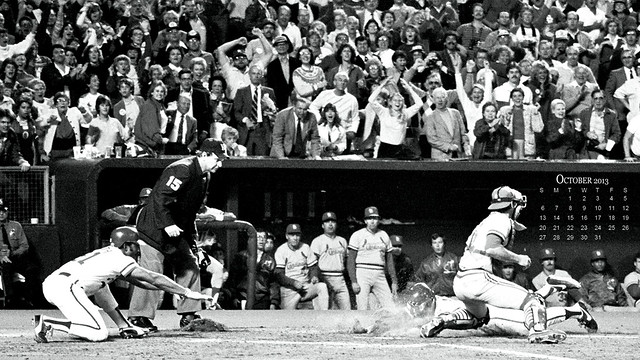Check out the above graph of the game-by-game accumulation of win probability added by the offense and defense and see if you can tell which one was better for the Royals last year! I'll give you a minute.
Lazy cliche spewers like to say pitching and defense win championships. People more interested in accuracy should try popularizing a new saying, something like, "the right combination of run creation and prevention will get you into the playoffs, where anything can happen." Doesn't have the same ring to it I guess. But the 2013 Royals were yet another example that you usually do have to score a little bit to be a playoff team. And another example that it's hard to score when you don't walk or hit dingers. Here's where the Royals offense ranked in the AL in a bunch of categories:
So pretty much all they did well was avoid strike outs, hit for average, and run the bases. The "little things" that don't contribute a whole lot to run scoring. They were mediocre at getting on base, and completely devoid of power, which led to an 11th place finish in run scoring. There were two stretches during the season when the offense completely disappeared that are glaringly obvious on the WPA chart at the top of this post. Between May 6 and June 4, the offense sputtered out 3.2 runs per game during a 6-22 stretch that effectively torpedoed the season. When the team got on a roll after the all-star break, it seemed as though they had dug themselves out of the hole they dug in May. But while the team deserves kudos for bouncing back the way they did, it's also true that there was never a strong chance for a playoff appearance after May. The offense had another terrible stretch from August 12-24 while their record fell from 62-54 to 64-64.
On the rare occasions that things were clicking on offense, it was Eric Hosmer, Billy Butler, Salvador Perez, and Alex Gordon carrying the load. But on the whole, they couldn't overcome the damage inflicted by out-machines Alcides Escobar, Mike Moustakas, Chris Getz, Elliott Johnson, and Jeff Francoeur. If the offense could have managed to just be league-average, which would have required them to score about 50 more runs, the Royals would have had a great shot at playing post-season baseball.
Finally, here's a look at how some Royals hit relative to their position. Instead of being compared to the whole league, this is OPS+ compared to the other AL players at respective positions:
The complaints about Butler from some in Royals-land never look sillier than when you directly compare him to average DH numbers. It's true that all he can do is hit. It's also true that there is a spot in the Royals lineup almost every game for someone to just hit. I personally like having a guy to put into that spot who is an excellent hitter. Call me crazy.









